In this post, you learn the grinding machine and grinding machine operation, types of grinding wheel and more.
Grinding Machine
A grinder is commonly used to precisely shape and finish the given materials with low surface roughness and high surface quality. A grinding machine is a type of machine used to grind workpieces. It basically uses emery or an abrasive wheel as the cutting tool.
The grinding process is truly a chip-producing machining process. The rough surface of the abrasive wheel spreads into small portions of the workpiece as required. It is also known as a grinder.
The grinding process is capable of producing very accurate sizes, equally accurate geometry like flatness or circles, and an extremely good surface finish. It is capable of machining hard, high-speed steel, which cannot be done by other machining processes.
Abrasive wheels are an impure form of aluminum oxide. A grinding wheel or bonded abrasive is made up of thousands of tiny abrasive particles inserted in a matric called as ‘bond’.
In bonded abrasives, porosity is essential to provide clearance for the chips being produced and to provide cooling. Otherwise, chips would interfere with the grinding process.
Read Also: What Are The Different Types of Coupling and Their Working? [PDF]
Parts of Grinding Machine
Following are the parts of grinding machine:
- Base or bed
- Column
- Work table
- Wheel head
- Wheel guard
- Grinding or Abrasive Wheel
- Crossfeed handwheel
- Coolant System
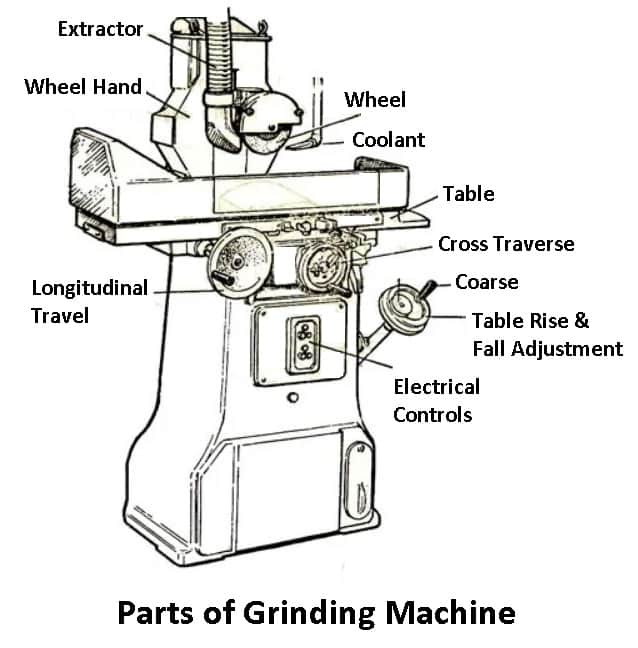
#1 Base or Bed
The horizontally positioned grinding machine bed, which is the machine’s bottom, supports all of the grinding components. Starting up a machine causes some vibration, so the base acts as a vibration absorber.
#2 Column
The abrasive wheel, wheel head, and wheel guard are kept in the column, which resembles a vertical pillar of the machine.
#3 Worktable
The workpiece is mounted on a flat surface called a worktable and is used for grinding. The workpiece is held by a worktable, which functions like a magnetic chuck.
#4 Wheel Head
The component of the machine that houses the worktable and grinding wheel spindle is called the wheel head. We can change the wheel head by using a feed hand. In order for the grinding wheel to make contact with the workpiece, lower this wheel head.
#5 Grinding or Abrasive Wheel
The rotating component of the machine that grinds the workpiece is called the grinding wheel. The wheel is constructed from abrasive grains that have been bonded together.
#6 Crossfeed Handwheel
In order to make a cut, the grinding wheel is moved across the workpiece by the cross-feed handwheel. Crossfeed moves the wheel head up and down or left and right. It is another crucial component of this machine.
#7 Coolant System
During grinding, the coolant system helps in keeping the workpiece and grinding wheel cool. Additionally, it facilitates in clearing away chips and debris.
Read also: What is Shaper Machine and The 4 Major Types of Shaper Machines
Hardness Comparison of Abrasive Material
An abrasive is a second hardest material, compared to diamond.
- Aluminium oxide (hardness of 2000-3000)
- Silicon carbide (hardness of 2100-3000). These are the perfect examples of conventional abrasives.
- The cubic boron nitrite (hardness of 4000-5000)
- Diamond (hardness of 7000-8000) comes under the category of super abrasives.
In addition to hardness, an important characteristic is called friability. Friability is the ability of abrasive grains to fracture (break) into small pieces. High friability indicates low strength or low fracture resistance of the abrasive.
For example, aluminum oxide has a lower friability than silicon carbide and has fewer tendencies to a piece. Bonded abrasives are marked with a standardized system of letters and numbers, indicating the type of abrasive, grain size, grade, structure, and bond type.
Read Also: 12 Types of Fasteners: Their Uses & Working with Examples [PDF]
Working Principle of Grinding Machine
A grinding machine operates by feeding the workpiece against a rotating abrasive wheel. The material is removed as a result of the rubbing or friction that occurs between the workpiece and the tool.
Let’s talk about how to use the grinding machine step by step.
- It would be best if you began by cleaning the machine with a fresh brush.
- Workpieces are attached to the worktables, and tools are attached to the tool holders at the bottom of the worktables. The grinding wheel is attached to the tool holders as well.
- We now adjust the tool and workpiece with the help of the traversing wheel, bring them into contact, and check that there is only a small gap since the machine has not yet started.
- In order to ensure that the coolant supply nozzle works as intended, you should make sure to place the tool between the workpiece and the tool, and to fill the nozzle with liquid so that when the operation begins, the liquid can be supplied automatically or manually as needed.
- The power is now being supplied to the system.
- Upon starting the wheel, the tool is brought into contact with the workpiece by the rotation of the wheel. You need to gradually increase the amount of feed as you get closer to your desired dimension.
Read Also: How To Perform Facing Operation? Working and Procedure [PDF]
Life of Grinding Wheel
When a grinding wheel is applied to the workpiece, the sharp edges of the abrasive grains which are cutting will, in the end, lose their cutting effect and become dull.
At that stage, the abrasive grains should either split or form new edges, or they should break away from the wheel, exposing the next layer of grains to do work.
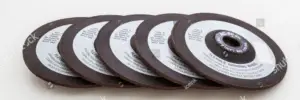
If the dulled grains stay in the wheel, they keep on rubbing on work without actually cutting. This defect is known as ‘glazing.’ If, on the other hand, the abrasive grains break away from the wheel or split prematurely, before becoming dull, it causes a reduction in life of the grinding wheel.
Selection of Abrasives in Grinding
- Emery and corundum are no longer used in modern grinding wheels.
- Instead, artificially manufactured abrasives are used due to their high purity. And they include silicon carbide and aluminum oxide.
#1 Silicon carbide
- Silicon carbide is greenish-black in color.
- It is harder and more brittle than alumina. For this reason, it is used for grinding materials of low grinding resistance, like cast iron, brass, and copper.
- The code for silicon carbide is C.
#2 Aluminium oxide
- It is reddish-brown in color.
- Aluminum oxide abrasive is more suitable for grinding most steels because of its greater toughness to cope with the increased grinding resistance offered.
- Aluminum oxide wheels it is A.
The abrasive, performance of grinding wheels also depends on many other factors. It is important that a suitable grinding wheel is selected for particular applications.
Read also: 22 Different Types of Lathe Machine Operations
Selection of Grinding Wheels
It means choosing the most appropriate wheel for a particular grinding machine operation. Wheel selection would depend on what abrasive is required, and characteristics of the wheels, and also on operating conditions like a wheel and work speed, type, and conditions of machines used.
The thumb rule is to use a hard wheel for soft material and a soft wheel for hard material. A hard wheel retains the abrasives as they do not get dulled easily on soft materials.
Bond and Types of Bond
Bond refers to the substance of which the matrix of the grinding wheel is made. The following bonds are generally used in the manufacture of grinding wheels. The bond hardness or grade is usually represented by the letters of the English alphabet.
A represents the very soft grade, while Z is very hard M and N represent medium grade hardness.
- Vitrified Bond
- Silicated Bond
- Shellac Bond
- Rubber Bond
- Resinoid Bond
1. Vitrified Bond
- It is denoted by letter V.
- About 80% of the wheels used in the industry are of this bond.
- It is also called as ceramic bond.
- They are strong, stiff, porous, and resistant to oils, acids, and water. They are brittle and lack resistance to mechanical and thermal shock.
2. Silicate Bond
- It is denoted by letter S.
- Silicate of soda (commonly known as water glass) is the main component of this bond.
3. Shellac Bond
- It is denoted by letter E.
- Shellac (a naturally available material) is the main component of the bond.
4. Rubber Bond
- It is denoted by letter R.
- This process involves mixing crude rubber, sulfur, and abrasive grains, rolling them into sheets, cutting out circles, and heating them under pressure to vulcanize the rubber.
- The wheels can be made like this and used as saws for cutting-off operations.
5. Resinoid Bond
- It is denoted by letter B.
- Resoniod bonding materials are thermosetting resins, and the bond is an organic compound, so the wheels with resinoid bonds are also called as organic wheels.
- Some of these wheels are made from bakelite and other resinous material.
Read Also: Working Principle of Hydraulic Press [Advantages & Disadvantages]
Wheel Grit, Grade, and Structure
#1 Grit
Grit indicates the size of the abrasive grain. It is indicated by a number. Higher the number, the smaller the size of the grains. Abrasives finer than 200, are called “flours” and designated as F, FF, and FFF.
The finer abrasive used by jewelers. For the fine finish of the ground surface,
- smaller grit size abrasive wheels are used. But their metal cutting capacity is limited.
- Large size abrasive wheels, finish is rough but metal removal rate is higher.
#2 Grade
The degree of hardness possessed by the bond is called the grade of the wheel and indicates the strength of the grip with which the abrasive grains are held in the bond.
It indicates the type and the amount of bond in the wheel. It is also referred to as the hardness of a bonded abrasive. A hard wheel has a stronger bond and a larger amount of bonding material between the grains than a soft wheel.
#3 Structure
The structure of a bonded abrasive is a measure of porosity (spacing between the grains). The structure of the bond material in a wheel varies from about 10% to 30% of its total volume. Structure of the bond depends upon this percentage.
If the abrasive grains are too strictly packed, the percentage of bond material will be on the lower side this is called a closed structure. If the abrasive grains are less strictly packed in the same volume, the wheels are called an open structure.
The structure is indicated by a number varying from 1 (very closed structure) to 15 (very open structure. On every grinding machine wheel, the manufacturers are limited to giving the following information. In specified sequence about the,
- Abrasive used (A or C)
- Grit number (ex: 46)
- Grade ( A to Z)
- Structure (1 to 5)
- Bond type (by letters)
In addition, the manufacturer is free to supply some additional information with the above information.
Read also: Slotter Machine: Types, Parts and Operations [Complete Guide]
Grinding Machine Operation
The common grinding machine operation are surface, cylindrical, internal and centreless grinding. Now let us discuss each one by one,
#1 Surface Grinding
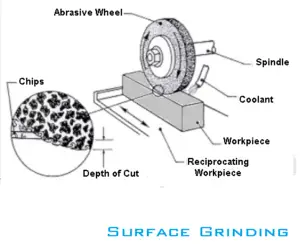
It involves grinding flat surfaces. Here the workpiece is fitted with a magnetic chuck attached to a work table of the grinder. Non-magnetic are held by vices or fixtures. A straight wheel is mounted on the horizontal spindle of the grinder. Transverse grinding occurs as the table reciprocates longitudinally and feeds laterally after each stroke.
#2 Cylindrical Grinding
In this, the operation is carried out on a cylindrical grinding machine which is made in two varieties, “plain” and “universal” type. The fundamental design is the same in both cases, but the universal machine can be adapted for internal grinding operation as well.
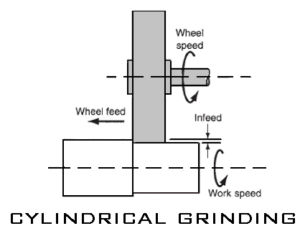
In cylindrical grinding machine operation, the work is mounted between two centers and is rotated. A grinding wheel is mounted on a spindle and revolves at a higher speed than the work. The depth of cut is very small, about 0.015 mm.
The work centers are mounted on a table that can transverse at various feeds so that the entire length of the work passes to and fro in front of the wheel.
When the entire work has passed in front of the wheel, the wheel advances forward by another 0.015mm at the end of the transverse, and so the cycle of machining goes on until the desired diameter of the workpiece is reached. The result is a long cylinder with a perfectly circular profile and a fine surface finish.
#3 Internal Grinding
The Internal grinding operation means, grinding of internal holes or bores. Internal grinding is designed for grinding the surface of bores, whether plain or tapered, with the help of a small grinding wheel mounted on a long slender spindle that can enter the bore.
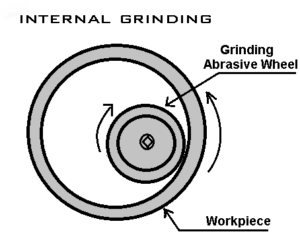
It is capable of giving improved geometry of the hole as well as the surface finish. This operation is performed on specially designed internal grinding machines. For internal grinding, a softer wheel is generally preferred.
#4 Centreless Grinding
It is a high-production process for continuously grinding cylindrical surfaces in which the workpiece is supported not by centers or chucks, but by a blade. Parts with a diameter as small as 0.1mm can be ground by this method.
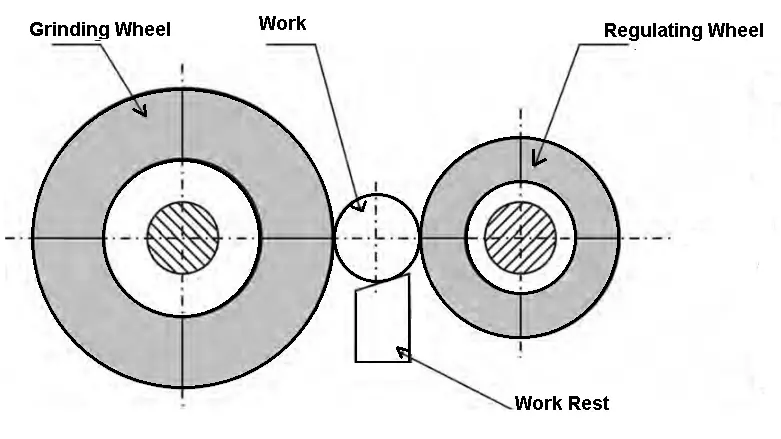
The surface speed of the wheel is about 10000m/min using cubic boron nitride abrasive wheels. Parts such as roller bearings, piston pins, engine valves, and camshafts are made by centreless grinding.
The feed-in case of centreless grinding is given as,
S = ΠDN sinα
Where,
- S = Feed
- D = Diameter of regulating wheel
- N = Speed in r.p.m
- α = Angle of tilt.
Types of Centreless Grinding
The following are the three types of centreless grinding,
- Through feed
- Infeed
- End feed
1. Through Feed
In this grinding, the whole length of the bar or shaft is grinded, which is placed on the work rest. The amount of material removed is 0.02 to 0.3mm.
2. Infeed
This type of grinding is used to grind parts that require multiple profiles to be grinded at the same time. The regulating wheel is moved backward to place the workpiece on the work rest. This type of grinding is mainly used for formed grinding stops provided at both ends.
13. End Feed
In this type of grinding the tapered parts are grinded either the grinding wheel or the regulating wheel will have a tapered form.
Advantages of Centreless Grinding
- A true floating condition exit, so that little amount of material is removed.
- There is no deflection of the work, and the small, fragile workpieces can be grinded easily.
- The process is continuous and used for production work.
- No extra attachments, such as centers, or chucks, are required.
- The size of the work is easily controlled.
- Unskilled labor is required.
Disadvantages of Centreless Grinding
- There is no concentricity when hollow workpieces are grinded.
- The workpiece having multiple diameters cannot be grinded easily.
Read Also: Types Of CNC Machine [Complete Guide] With PDF
Advantages of Grinding Machine
- Tight tolerance high precision parts can be produced by grinding machines.
- It eliminates the need for multiple machines and setups by performing multiple operations in a single configuration.
- In some cases, grinding machines can be more economical than other machining techniques, especially for large production runs.
- Grinding machines can be used for roughing and finishing operations on various materials such as metal, plastic, and ceramics.
- To protect the operator from injury, modern grinding machines include safety features such as interlocks and guards.
Disadvantages of Grinding Machine
- Particularly if they are automated or computerized, grinding machines can be pricey.
- In some environments, the noise that grinding machines can make can be an issue.
- Grinding machines can generate a lot of dust and debris. If it is not properly controlled, it can harm the operator’s health.
- To get the desired results from grinding machines, a skilled operator is needed.
Closing It Up
If you have any doubts or suggestions regarding the “grinding machine” post, please feel free to ask in the comment section we’ll respond to you.
Want free PDFs direct to your inbox? Then subscribe to our newsletter.
Read Next:
Thanks excellent wort
You’re welcome.
we appreciate your work . god bless you
Thanks for your feedback.
Sir am kindly asking were I can download these notes from about grinding they are so well simplified
I have updated the article with PDF file, now you can download it.
I have updated the article with a PDF file, now you can download it.
Grinding Machine Manufacturers in India
I would like to thank you for the efforts you have made in writing this blog. Very Informative post.
You’re welcome
Sir I’m unable to understand the suction of your article term as infeed grinding. Would you like to explain it another way.
Thank you for this kind of amazing article it helped me a lot.
Infeed grinding is used to grind parts that require multiple profiles to be grinded at the same time. You’re welcome 🙂